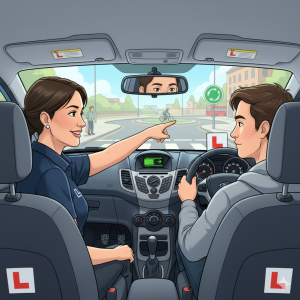The Secret to Passing Your UK Driving Test

Awareness & Planning
🚦
When it comes to the UK practical driving test, many learners focus on clutch control, manoeuvres, or hill starts. But one of the most important skills examiners look for is awareness and planning.
In simple terms, awareness means noticing what’s happening around you, and planning means deciding in advance how you’ll deal with it. Together, they show the examiner that you’re a safe, confident, and responsible driver.
Let’s break this down step by step.
🔎 1. Observation – Training Your Eyes to Spot Hazards
Driving isn’t just about steering and pressing pedals – your eyes do most of the work.
- Look well ahead: Don’t just stare at the bonnet. Train yourself to scan the road far ahead, including pavements, side roads, and traffic.
- Use mirrors regularly: A good rule is mirror–signal–manoeuvre. Check the interior mirror first, then the relevant side mirror before you slow down, change direction, or signal.
- Blind spots matter: Before moving off, changing lanes, or merging, always check your blind spot with a quick head turn.
👉 Examiners notice when learners check mirrors at the right times – so make your observations clear and obvious.
🚲 2. Anticipation – Expect the Unexpected
Safe driving means being prepared for surprises. Anticipation is the skill of predicting what might happen.
Look out for:
- Children playing near the road or stepping off the kerb.
- Cyclists swerving to avoid potholes or car doors opening.
- Parked cars with drivers inside who may suddenly pull out.
- Buses stopping and passengers crossing the road.
- Brake lights and indicators from cars ahead giving you early clues.
👉 If you’re alert, you can respond early and avoid last-minute braking or swerves, which examiners don’t like to see.
🛣 3. Planning Ahead – Staying in Control
Good planning shows you’re in charge of the situation.
- Prepare for junctions and roundabouts: Don’t leave decisions until the last second. Position your car early, reduce speed, and signal in good time.
- Read the road: Keep an eye on road signs, traffic lights, and markings. They tell you what’s coming before you reach it.
- Adjust for conditions: If it’s raining, dark, or the road is narrow, slow down and give yourself extra space.
👉 Planning ahead avoids panic reactions and keeps your driving smooth – something examiners really value.
🚧 4. Dealing with Hazards Calmly
Examiners pay close attention to how you handle hazards.
- Approach calmly – ease off the accelerator and cover the brake.
- Decide early – should you stop, slow down, or move around the hazard?
- Communicate clearly – use signals when needed so other drivers know your intentions.
👉 Whether it’s a cyclist, roadworks, or a pedestrian crossing, dealing with hazards safely is a key part of the driving test.
⚠️ 5. Common Mistakes Learners Make
Many test fails happen not because learners don’t know how to drive, but because of poor awareness or late planning. Here are the most common slip-ups:
- Forgetting to check mirrors before signalling or slowing down.
- Rushing at roundabouts and not waiting for a safe gap.
- Failing to notice pedestrians near crossings.
- Driving too close to parked cars or cyclists.
- Leaving manoeuvres (like turning or lane changes) until the last moment.
👉 Knowing these mistakes helps you avoid them on your test day.
🌟 6. Tips to Impress Your Examiner
- Be confident but not rushed – safe decisions are more important than fast ones.
- Make your checks clear – examiners like to see you using mirrors and blind spot checks.
- Keep safe distances – from vehicles, cyclists, and pedestrians.
- Drive smoothly – avoid harsh braking by planning ahead.
👉 Remember, examiners don’t expect perfection – they want to see safe, responsible driving with good awareness of everything happening around you.
✅ Final Word
Awareness and planning are not just test skills – they’re lifelong driving habits. If you practise looking ahead, anticipating hazards, and planning early, you’ll not only increase your chances of passing your test, but you’ll also become a safer driver for life.
So next time you’re out practising, focus on what’s happening 30 seconds ahead, not just right in front of your car. That’s how you’ll show your examiner that you’re ready to join the road as a fully licensed driver.

